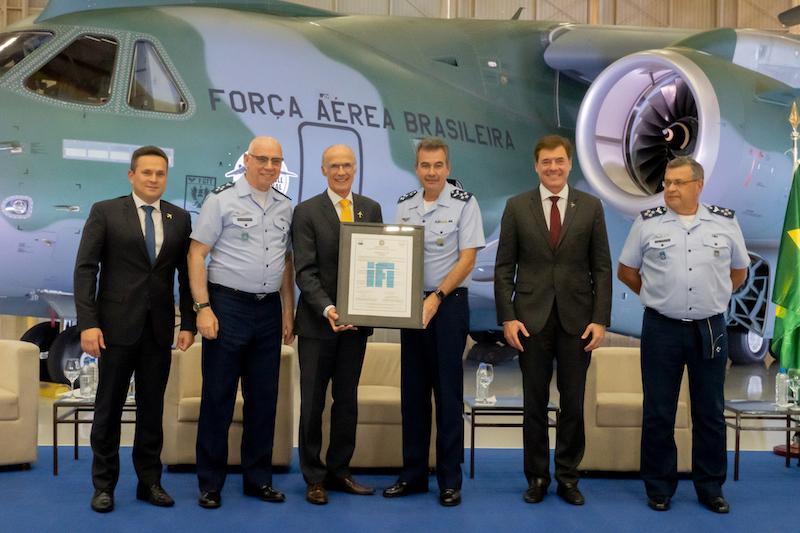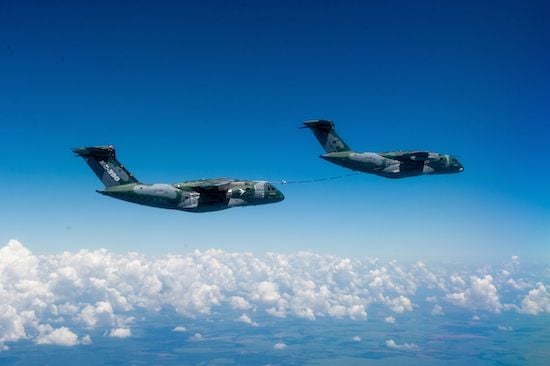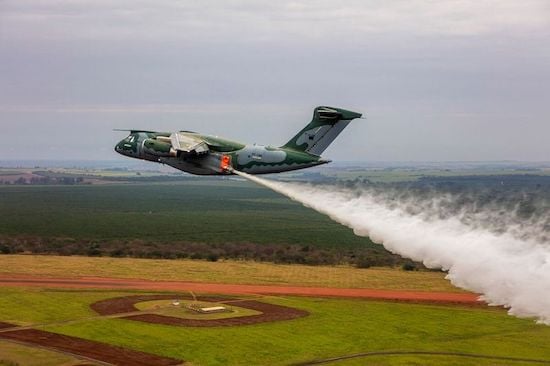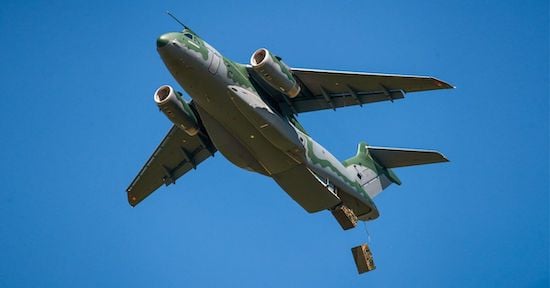C-390 MILLENNIUM. CERTIFIED FOR EVERY MISSION.

After an exhaustive series of tests Embraer’s C-390 Millennium has been awarded a Full Operational Certificate (FOC) confirming it is fully capable of delivering the missions for which it was designed. Read more.
Full Operational Capability (FOC) recognition gives C-390 Millennium the edge
It’s an exciting time to be redefining the airlift environment, to challenge the thinking behind current and future generation platforms. Air Forces around the world are similarly focused on matching their ever-evolving operational needs with what they can afford, having been obliged through economic and practical necessity to re-evaluate their procurement strategies. They recognize that their choice of aircraft now will impact their operational capabilities for years to come.
It's why the award of a Full Operational Capability (FOC) certificate to the Embraer C-390 Millennium is such important news. Put simply, it means that after an exhaustive series of tests, the aircraft is confirmed as being fully capable of delivering the missions for which it was designed, as a multi-mission military transport aircraft with flexibility at its core, setting a new standard in medium air mobility.
The award of an FOC certificate puts the C-390 in a select group of aircraft types. It follows months of evaluation from experts at the Industrial Fostering and Coordination Institute (abbreviated to IFI in Portuguese), the Brazilian authority responsible for certifying aircraft for military use. IFI is itself recognized as the Military Airworthiness Authority (MAA) by the National Airworthiness Council (NAC) in the US. It provides the mutual validation of inspection, certification, production and continued airworthiness activities for aerospace products and systems under the responsibility of both countries.
The C-390 underwent a full military certification process built over a dual certification approach in which the basic platform (the ‘green’ aircraft) was developed and certified in accordance with civil applicable regulations, equivalent to 14 CFR Part 25, and the military certification was based on the set of technical and operational requirements established by the Brazilian Air Force Chief-of-Staff for the aircraft.

Achieving FOC celebrates the successful conclusion of one of the largest and most complex aircraft design projects ever undertaken in the southern hemisphere and signals the similarly successful partnership between the Brazilian Air Force and Embraer. The genesis of the Millennium is in the triple helix model, the culmination of bringing together the greatest minds in academia, industry and government. The C-390 also has proven systems from established suppliers. Embraer works with more than a dozen global partners who, between them, deliver some 60% of the Millennium’s parts, equipment and systems. This ensures a global spread of expertise, including the knowledge and capability to support C-390 Millennium aircraft wherever they are operating.
As an example, the aircraft is powered by two IAE V2500 engines, chosen as they have accrued more than 250 million hours in commercial aviation operations with a wide global maintenance, support and spare parts network, bringing significant performance and economic benefits. Another example is the use of Rockwell Collins’ Pro Line Fusion, an integrated avionics system. It features scalable architecture, total connectivity, intuitive decision-making tools, and advanced situational awareness capabilities to enhance the safety and efficiency of every mission.
There are other factors worthy of consideration: the C-390’s full fly-by-wire capability, for example, significantly reduces the flight crew workload across all of the missions it is designed for, as well as negating the need for any control cable inspections and adjustments.
The result, following years of development, testing and certification, is a design established to the highest standards in the market. It is proven in operation with exceptionally high levels (circa 80%) of operational availability and a completion rate (operational reliability) above 99% in the Brazilian Air Force - a truly remarkable statistic. It is also expected to deliver a sizeable reduction in downtime in the coming years, compared to the previous solution, as a result of more efficient maintenance methods (e.g. MSG-3) and an optimized plan.

Describing the C-390 Millennium as a cargo carrier perhaps underplays its full capabilities. Such is its flexibility that its interior and exterior can be quickly and easily modified to accommodate different needs: aerial assault; aerial resupply; aerial firefighting; aeromedical evacuation; aerial refuelling, humanitarian aid support; search and rescue; special operations. More than this, it can also be reconfigured as both a tanker and receiver aircraft for in-flight refuelling, by day or by night. All of this contributes to reducing the size and variety of the fleet needed.
The C-390 completed three years of operation in September 2022. There are currently five aircraft being operated by the Brazilian Air Force, with more than 8,000 flight hours completed by the fleet, and with some of the aircraft having surpassed 850 flight hours per year in their own right. Throughout the testing regime, more than 3,500 hours were flown in the aircraft prototypes and a further 85,000 hours were spent in lab tests.
As part of the C-390 certification process, several tests and regular missions were performed, including airlifting special loads such as light and heavy-weight vehicles and helicopters, ground combat offloads and gravity air drops. They also included heavy loads/extraction air drop, validating the continuously computed drop point (CCDP) performance in flight. Most of the airdrop tests were conducted at Yuma Proving Ground, in the US.
Other systems validated included self-protection systems such as missile approach, radar warning receiver and countermeasure dispenser systems, the directional infrared counter measures (DIRCM), and the search and rescue equipment. They were proven in extremes of temperature and environment, from cold weather operation in Alaska and Antarctica to the hot and arid Atacama Desert in Chile, passing through areas of high humidity such as The Amazon and high altitudes such as La Paz, Bolivia.

The aircraft is proven not only in air-to-air refueling, but also in refueling other C-390 aircraft. It is similarly capable of delivering free fall and static line parachute drops, medical evacuation, and firefighting, operating from temporary or unpaved runways (i.e comprising compacted dirt, soil and gravel).
The C-390 Millennium had to satisfy well in excess of 4,300 different requirements, and more than 2,600 reports were issued by the Engineering team and millions of hours of work before FOC certification was achieved.
For the present, the Embraer team is justifiably celebrating its landmark achievement. Embraer is also looking to the future. This includes conforming to NATO’s systems’ integration, tests and certification. Several programs are already well underway – including initiatives in Portugal and Hungary – as evidence of a collaborative approach with partners who have chosen the Millennium to meet their future needs. It is in this spirit that the Dutch Government has selected five aircraft for its Air Force, having fully evaluated the C-390 Millennium and declared it the only candidate that can meet its operational and budgetary requirements.




